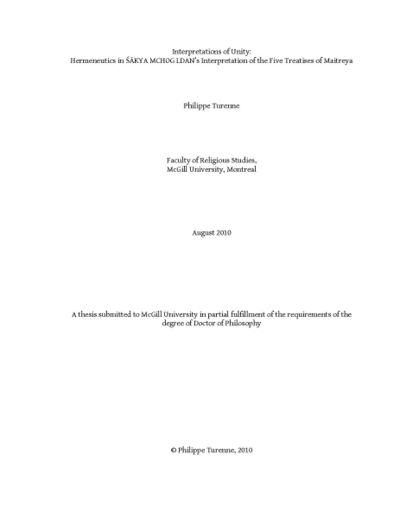Interpretations of Unity: Hermeneutics in Śākya mchog ldan's Interpretation of the Five Treatises of Maitreya
< Books(Redirected from Interpretations of Unity: Hermeneutics in Śākya mchog ldan's Interpretation of the Five Treatises of Maitreya)
Abstract
This dissertation is a study of the process through which Tibetan Buddhist philosophy, by synthesizing doctrines and texts into consistent models, integrates views of reality within doctrinal and soteriological systems. It consists of an analysis of the most fundamental doctrinal tension found in the Tibetan tradition, namely the apparent inconsistency of doctrines belonging to the negative Mādhyamika and to the more affirmative Yogācāra trends of Mahāyāna Buddhism. As a case study aiming to provide a first systematic examination of that problematic, the dissertation surveys and analyzes Tibetan interpretation of the set of texts referred to as the Five Treatises of Maitreya (byams chos sde lnga), and at the way those interpretations deal with the doctrinal tensions found in that set of text. In addition to providing a recension of major interpretations of the Five Treatises developed between 1100 and 1500, a detailed account is given of the model of interpretation given by gSer mdog Paṇ chen Śākya mchog ldan, a famous teacher of the Sa skya school of Tibetan Buddhism. When confronted with the features of other interpretations, Śākya mchog ldan's interpretation of the Five Treatises, which proceeds primarily by allowing a plurality of views to be maintained even at the level of definitive meaning, provides us with a new insight in the Tibetan philosophical tradition: the most fundamental dimension of philosophical reconciliation of doctrinal views, especially of the kind found in the Five Treatises, can be described as pertaining to textual hermeneutics. Moreover, Śākya mchog ldan's contribution to that domain of Buddhist thought, by placing hermeneutics at the very centre of his system of Buddhist doctrine and practice, suggests that hermeneutics is a fundamental category of all Buddhist philosophical debates, and that it should be part of any attempt to understand the Tibetan philosophical tradition.
| Citation | Turenne, Philippe. "Interpretations of Unity: Hermeneutics in Śākya mchog ldan's Interpretation of the Five Treatises of Maitreya." PhD diss., McGill University, 2010. https://archive.org/details/interpretationsofunityhermeneuticsinsakyamchogldaninterpretationoffivetreatiseso_985_N/mode/2up. |
|---|---|

